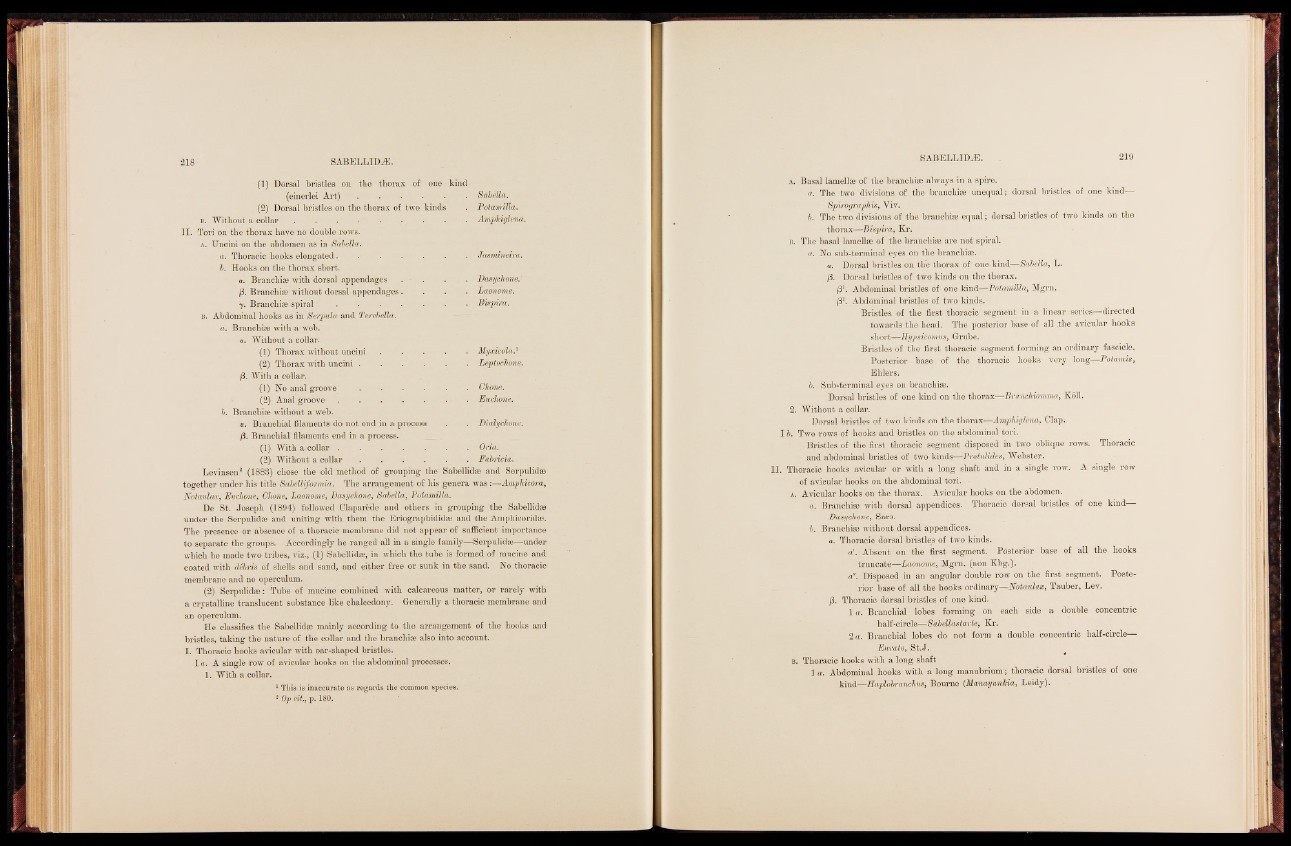
(1) Dorsal bristles on the thorax of one kind
(einerlei Art) w . . . • . . Sabella.
(2) Dorsal bristles on the thorax of two kinds . Potamilla.
b. Without a collar . . .
Tori on the thorax have no double rows.
a. Uncini on the abdomen as in Sabella.
. Amphiglena,
a. Thoracic hooks elongated .
b. Hooks on the thorax short.
. Jasmineira.
a. Branchiæ with dorsal appendages . . . . Dasychone.
(3. Branchiæ without dorsal appendages. . Laonome.
■ y. Branchiæ spiral . . . . . .
b. Abdominal hooks as in Serpula and Terebella.
ft. Branchiæ with a web.
a. Without a collar.
. Bispira.
(1) Thorax without uncini . Myxicolâ.1
(2) Thorax with uncini . . .
(3. With a collar.
. Leptochone.
(1) No anal groove . . . . . . Ghone.
(2) Anal groove
b. Branchiæ without a web.
. Euchone.
a. Branchial filaments do not end in a process
/3. Branchial filaments end in a process.
. Dialychone.
(1) With a collar . . . . . . Oria.
(2) Without a c o l l a r ..................................... . Fabricia.
Levinsen2 (1883) chose the old method of grouping the Sabellidæ and Serpulidæ
together under his title Sabelliformia. The arrangement of his genera was :—Amphicora,
Notaidax, Euchone, Ghone, Laonome, Dasychone, Sabella, Potamilla.
De St. Joseph (1894) followed Claparède and others in grouping the Sabellidæ
under the Serpulidæ and uniting with them the Eriographididæ and the Amphicoridæ.
The presence or absence of a thoracic membrane did not appear of sufficient importance
to separate the groups. Accordingly he ranged all in a single family—Serpulidæ—under
which he made two tribes, viz., (1) Sabellidæ, in which the tube is formed of mucine and
coated with débois of shells and sand, and either free or sunk in the sand. No thoracic
membrane and no operculum.
(2) Serpulidæ: Tube of mucine combined with calcareous matter, or rarely with
a crystalline translucent substance like chalcedony. Generally a thoracic membrane and
an operculum.
He classifies the Sabellidæ mainly according to the arrangement of the hooks and
bristles, taking the nature of the collar and the branchiae also into account.
I. Thoracic hooks avicular with oar-shaped bristles.
I a. A single row of avicular hooks on the abdominal processes.
1. With a collar.
1 This is inaccurate as regards the common species.
3 Op cit., p. 180.
a. Basal lamellae of the branchiae always in a spire.
a. The two divisions of the branchiae unequal; dorsal bristles of one kind——
Spirographis, Viv.
b. The two divisions of the branchiae equal; dorsal bristles of two kinds on the
thorax—Bispira, Kr.
b. The basal lamellae of the branchiae are not spiral.
ft. No sub-terminal eyes on the branchiae.
a. Dorsal bristles on the thorax of one kind—Sabella, L.
/3. Dorsal bristles of two kinds on the thorax.
/31. Abdominal bristles of one kind—Potamilla, Mgrn.
(P. Abdominal bristles of two kinds.
Bristles of the first thoracic segment in a linear series—directed
towards the head. The posterior base of all .the avicular hooks
short—Hypsicomus, Grube.
Bristles of the first thoracic segment forming an ordinary fascicle.
Posterior base of the thoracic hooks very long—Potamis,
Ehlers.
b. Sub-terminal eyes on branchiae.
Dorsal bristles of one kind on the thorax-—Branchiomma, Koll.
2. Without a collar.
Dorsal bristles of two kinds on the thorax—Amphiglena, Clap.
I b. Two rows of hooks and bristles on the abdominal, tori.
Bristles of the first thoracic segment disposed in twp oblique rows. Thoracic
and abdominal bristles of two kinds—Protulides, Webster.
II. Thoracic hooks avicular or with a long shaft and in a single row. A single row
of avicular hooks on the abdominal tori.
a. Avicular hooks on the thorax. Avicular hooks on the abdomen.
ft. Branchiae with dorsal appendices. Thoracic dorsal bristles of one kind-H
Dasychone, Sars.
b. Branchiae without dorsal appendices.
a. Thoracic dorsal bristles of two kinds.
a'. Absent on the first segment. Posterior base of all the hooks
truncate—Laonome, Mgrn. (non Kbg.).
ft". Disposed in an angular double row on the first segment. Posterior
base of all the hooks ordinary—Notaulax, Tauber, Lev.
/3. Thoracic dorsal bristles of one kind.
1 ft. Branchial lobes forming on each side a double concentric
half-circle—Sabellastarte, Kr.
2 ft. Branchial lobes do not form a double concentric half-circle—
Eurato, St.J.
B. Thoracic hooks with a long shaft
1 ft. Abdominal hooks with a long manubrium; thoracic dorsal bristles of one
kind—Haplobranchus, Bourne (Manayunkia, Leidy).